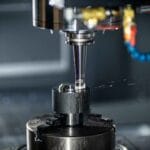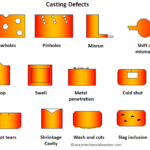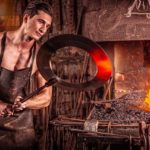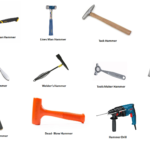1. Introduction
The World is moving fastly, Increasing almost at an exponential rate. This fast-Moving World has also increased the demand for finished products. Car manufacturing companies have almost increased their sales by 5-fold or even more in the last twenty years. This demand has led us to adopt new techniques for fast, simple, and cost-effective manufacturing. Rolling is One of those processes and is widely used in many industries. This article will discuss various types of Rolling Process, starting with an Introduction to Rolling.
2. What is Rolling Process
Rolling Process is a deformation process in which Metal(s) in its semi-finished or finished form is passed between the two opposing rollers, which reduces the metal’s thickness through the compression process. The rollers rolls around the metal as it squeezes in between them.

3. Working Principle of Rolling
The Rolling Process consists of two opposing rollers and a metal squeezing in between them. The basic consideration is that the thickness between the rollers should be less than the Metal’s (Ingot) Initial Thickness. This consideration will help metal’s forward motion as it passes through the gap between the Rollers. Rolling Process decreases the Thickness of Metal and Increases its Length and Breadth, Keeping Overall Volume Constant.
4. Terminology used In Rolling Process
The most common terminologies used in rolling are as follows:
- Ingot: It is the Starting Metal that is Provided Input to the Rolling Process. The Ingot is a forging terminology, where metal is taken out from the cast with various defects.
- Bloom: It is the first rolled product of Ingot, with a Cross-section area of more than 230 cm2.
- Billet: The product is obtained by further rolling of Bloom, having an area of Cross-section greater than 1600 mm2.
- Slab: It is a hot Rolled Ingot, with a Cross-section area greater than 100 cm2 and Width>=2*thickness.

Fig.: Billet, Bloom and Slab
These Above are some common Semi-finished Products, now we will be looking into Mill Products.
- Plate: It is the Mill product, with thickness more than 6 mm.
- Sheet: It is a Mill product, with thickness less than 6 mm, and width greater than 600 mm.
- Strip: It is a Mill product with thickness less than 6 mm, and width less than 600 mm.

Fig.: Plate, Sheet, and Strip
For a more detailed study, we can refer to few more terminologies:
- Foil: It is a thin strip, with a width of 300 mm, and a maximum thickness of 1.5 mm.
- Bar: It is a Uniform circular cross-section Object, in the form of a Cylinder.
- Wire: It is a bar with a small area of cross-section, which may go up to 9.5 mm.
5. Working of Rolling
The Woking of Rolling might be clear from its basic definition. It is a Manufacturing Process consist of Rollers that are present at a distance from each Other. The Metal in its Semi-finished or finished form is squeezed through the Rollers gap, sliding at the ends.
Rolling Process has three stages of Completion, which are discussed as follows:
Primary Rolling:
It is the Primary stage of Thickness reduction, in which Ingot is changed into simple stock members like bloom and slab. This process refines the structure, improves the mechanical properties, and removes Internal defects.
Hot Rolling:
Blooms and Slabs Obtained by Primary rolling are converted into plates, sheets, rods, and Other secondary members through Hot Rolling.
Cold Rolling:
This is a final finishing process, in which the Final products Obtained are given good surface finish, tolerances, and enhancing their mechanical properties.

Also Read:
- What is Milling Machine – Operation, Parts and Types.
- What is Lathe Machine? Main parts, Operations and Working
- What is Slotter Machine – Parts, Types, Working, Operations, Advantages and Disadvantages?
6). Types of Rolling Mills
Rolling mills consist of set-up that rotates the roller and helps in initiating and completing the Rolling Process. It consists of one or more roller stands, reducing gear, the main drive motor, Stand Pinion, Flywheel, and Coupling gear between the Units. These Components equipped together to help in the Completion of the Rolling Process.
Rolling mills are classified on the basis of the number and arrangement of rolls in a stand. There are commonly six types of Rolling mills that are used, they are as follows:

(i) Two-High Rolling Mill:
It Consists of two High stands, and two rolls placed exactly one over the Other. In this type of Rolling Mill, the Rollers rotates in Opposite direction and their direction changes after each Metal pass. The Metal (Ingot) is passed continuously and approximately 25-30 passes are required to convert Ingot to Bloom.

(ii) Three-High Rolling Mill:
It consists of three high stands and three Rollers present in the same vertical plane. The Top and bottom roller rotate in the same direction, and the middle roller rotates in the Opposite Direction. In this type of Rolling mill, the Direction of the drive is not changed after each pass. It is more Productive and easier with respect to the two-High Rolling Mill.

(iii) Four-High Rolling Mill:
It Consists of two backup rollers and two Working rollers, arranged One over the Other in the same Vertical Plane. The Diameter of Backup rollers is always greater than the Working rollers. This type of rollers is mainly used in Sheet Rolling.
The Two Working Rollers of small diameters are used to reduce the power demands, but it increases the chance of bending of working rollers, and as a result, non-Uniform compression of sheets. This is the reason we use Backup rollers for reducing the bending of Working rollers.

(iv) Cluster Mill:
It consists of Two Working rollers and two or more backup rollers. The number of Backup rollers depend upon the amount of support required for working. It is mostly used in Cold rolling Operations.

(v) Multi-High Roll Mill:
It consists of two small diameters of working rollers and an intermediate row of driving rolls, and a row of Backup rollers. The arrangement is made in such a way that the whole system achieves exceptional rigidity. Multi-High Rolling mills are used for making a sheet of minimal thickness.

(vi) Universal Rolling Mill:
It consists of two vertical rollers and two Horizontal rollers. The Vertical rollers are arranged between the bearing of horizontal rollers in the vertical plane. It is widely used to produce blooms from Ingot, and for rolling wide flange H-Section beams.
Also Read:
- What is Forging – Definition, Types, Advantages and Defects? – Complete Explanation
- Blast Furnace: Introduction, Definition, Construction, Working Principle, Applications & Advantages
- What is Casting Defects – Types, Causes and Remedies?
7. Types of Rolling Process:
Rolling of Metal can be performed in a variety of ways, which are used according to applications. The Selection of the Type of Rolling Process depends upon the Quantity of Product, the condition of Manufacturing, Etc. Depending upon these requirements, Rolling Process are classified as follows:

(i) Thread and gear Rolling:
In this Process, Thread dies are present on the Rollers. The Dies are pressed against the Metal Input, and by rolling over the Metal, it forms thread on Metal. This process is mainly used to cut threads and gears.
(ii) Shape Rolling:
This type of Rolling Process is used to cut shapes on various Metal (Workpieces). It is used to roll I-Section, H-Section, Etc. Various Different Rollers are used on the Metal to change its shape. The arrangements and shape of rollers depend upon the required final shape. It is a very accurate method.
(iii) Ring Rolling:
There are three-roller present, a Drive Roller, an Idler roller, and an Axial roller in this type of Rolling. The two main rollers (Drive roller and Idler roller) rotate in the same direction. The Idler roller rotates Inside the Metal, and with the Increase in hole diameter, the rollers move closer to each Other.

(iv) Tube Piercing:
This type of rolling process consists of two Rollers and a stationary mandrel. The rollers rotate on the Metal, and the Metal moves forward towards the mandrel. Metal’s movement toward the mandrel creates a hole inside the Metal due to the mandrel’s compressive stress. It is used to make a seamless hollow tube of a thick walls.

(v) Skew Rolling:
This type of rolling process is used to make ball bearing. In this process, metal is passed through the specially designed roller, and bearing balls come out as a finished product. It is a very convenient method that we can use in the mass manufacturing of ball bearings.

Fig. 17: Skew Rolling
(vi) Transverse Rolling:
This type of rolling is used to provide a tapered surface to the material. It consists of two rollers that rotate in the same direction, and metal is passed between them. The Rollers also contain a certain tapered portion that induces tapered on the Surface of the metal. It is used in the manufacturing of tapered shaft, leaf springs, Etc.

(vii) Roll Bending process:
This type of Rolling process is used to bend the metal passed through it. The rollers are arranged that, when the metal is passed through it, gets a curvature along the roller’s direction. The roll bending process is mainly used in bending tubes of chassis for the vehicle, which increases its aerodynamic efficiency.

(viii) Flat Rolling:
It is the most basic rolling process, that are used to convert the Ingot into bloom, slab, etc. Flat metal is provided as Input and is given Output in the same direction with the reduced thickness. In brief, we can say that, in this type of rolling, the thickness of metal is reduced at the Output only.

(ix) Controlled Rolling:
As indicated by the name, it is one of the types of rolling processes performed in a controlled manner. It is widely used in Industries. E.g., In steel Industries the grain size is fixed, and rolling is performed in a controlled manner to give the same grain size at the Output.
For a more clear explanation of rolling process, watch the video given below:
8. Application of Rolling:
Rolling Process is one of the most widely used processes in Industries. It is used to manufacture things ranging from balls of bearing to turbines. Apart from this, the rolling process is also used for mass manufacturing of sheets, strips, wires, bars, slabs, etc. which are the secondary products in the rolling process.
It must always be remembered that the rolling process is primarily used to change the shape of metal, which led to different applications in various fields.
9. Defects in Rolling Products:
Several defects are arises in the rolling process. These defects are as follows:
(i) Edge Cracking:
This Occurs due to limited ductility of the material, or uneven deformation, mainly at the edges. This type of deformation Occurs mostly in Ingots, plates, or slabs.
(ii) Alligatoring:
In this type of defect, the Metal tears down into 2 Pieces in the Horizontal Plane. It mainly Occurred with slabs and Occurs when slab thickness to the length of Contact falls between 1.4 to 1.65.

(iii) Folds:
This type of defect occurs when the reduction per pass is minimal. Folds are very frequent in plate rolling.
(iv) Scale Formation:
In this type of defect, an Oxide layer is formed above the metal layer. Scale formation Occurs during the Hot Rolling Process.
FAQs
Q.1: What is the difference between controlled rolling and Other types of rolling processes?
Answer: Controlled rolling means the rolling process performed in a controlled manner. If the Other types of rolling process will be performed in a controlled manner, than they will also be called controlled rolling process.
Q.2: How Universal rolling mill is different from Other types of Rolling mill?
Answer- Universal rolling mill can perform rolling in both X and Y directions, and is not specified in a certain direction as other rolling mills.
Q.3: How is Hot and cold rolling different from the types of Rolling?
Answer- Hot and Cold rolling is performed on all metals undergoing rolling process, and is classification based on temperature of rolling. The Rolling process classification here done is based on different application and arrangements of components.









